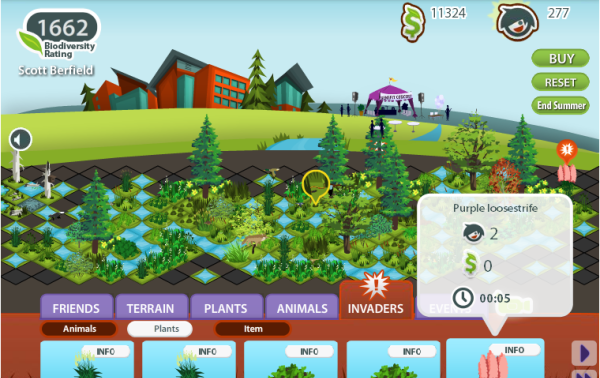Undergraduate students at the University of Washington Bothell’s Center for Serious Play created and released today a Wetlands restoration video game for Facebook entitled UWB Wetlands Restoration.
[aditude-amp id="flyingcarpet" targeting='{"env":"staging","page_type":"article","post_id":379613,"post_type":"story","post_chan":"none","tags":null,"ai":false,"category":"none","all_categories":"games,","session":"D"}']UWB Wetlands Restoration’s Jordan Weisman, interim director at the CSP and a veteran game developer, helped design and create the game with the focus of helping players to understand how important it is maintain and help restore the Wetlands ecosystem. Not only does the project educate students about an environmental issue, it also trains them how to make games. As such, it’s not a bad way to create the next generation of game developers.
Weisman had this to say about choosing the Wetlands as the basis for the game, “We were looking for a subject that captured some of the unique aspects of the UW Bothell campus, had a strong educational aspect to the play pattern, and a well understood game dynamic that the students could adapt to the subject matter.”
The game was created from concept to “ship” by undergraduate students from the university. It will be playable for free on Facebook, and allows players to build their Wetlands from the beginning of their existence to full fledged Wetlands churning with all kinds of plants, animals and even threats to the player’s beloved ecosystem.
But to create a game based on Wetlands restoration, Scott Berfield, CSP executive producer, Weisman and the team of undergraduates had to consult with Warren Gold, UWB ecology professor, and his team of ecology graduates to grasp just how to transfer the science of Wetlands into video game form.
Weisman couldn’t stress enough how important this collaboration was to the development of the game. He went on to say, “The ecology department was a huge help and deeply involved in helping the students and our consulting designer Mike Mulvhill reduce the complicated science into a set of actions that players could perform and yet understand the steps and links needed for the 50 year process of restoring a wetlands.”
Essentially starting with an empty piece of land, players are given different types of options such as terrain, plants, food and shelter to help their Wetlands to grow and to attract wildlife. Timeframe is especially important in UWB Wetlands Restoration as the two seasons, winter and summer, create different challenges that the player must be aware of and take action to continue to protect and grow the ecosystem.
To continue to build up your very own section of Wetlands, players will be able to buy resources with two types of currency, donations and grant funds. Grant funds are given in the beginning of the game and are used throughout the game whereas donations are given to the player as they invite and help other players or spend actual money to purchase in-game currency. Also, every time players purchase in-game currency, 80 percent of proceeds will go to restoring the actual Wetlands ecosystem located at the university with the other 20 percent helping to maintain game maintenance.
Not only is this game benefiting Wetlands Restoration at the university, but is also an outlet to help students get a foot in the door in the game industry. Undergraduate students created this game from beginning to finish in possibly the only program in the country allowing undergraduates to create an entirely new video game from concept to the finished product. (Most universities in the US only have this type of program for graduate students.)
[aditude-amp id="medium1" targeting='{"env":"staging","page_type":"article","post_id":379613,"post_type":"story","post_chan":"none","tags":null,"ai":false,"category":"none","all_categories":"games,","session":"D"}']
Weisman has worked in the game industry for over 30 years and has worked on plenty of games over that time period. When asked what was different about developing this game rather than his previous developed games, he said, “What was unique here is that the students at the CSP are undergrads and thus most of their involvement in CSP projects are extra-curricular which means that these students really want to be involved and make the time to do so, which means they bring a terrific amount of energy to the projects they are involved.”

